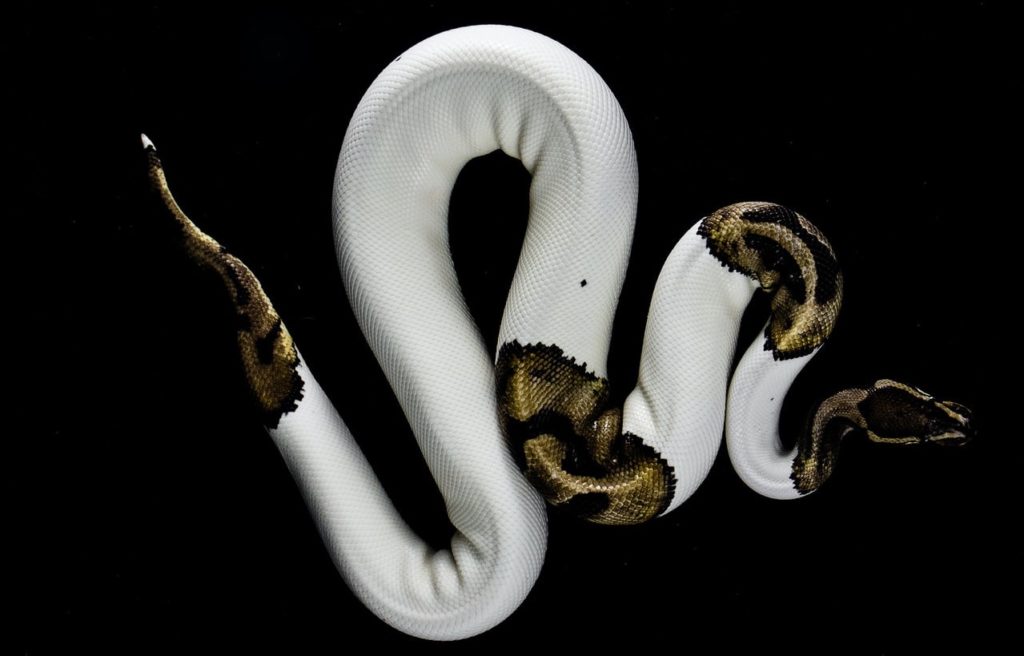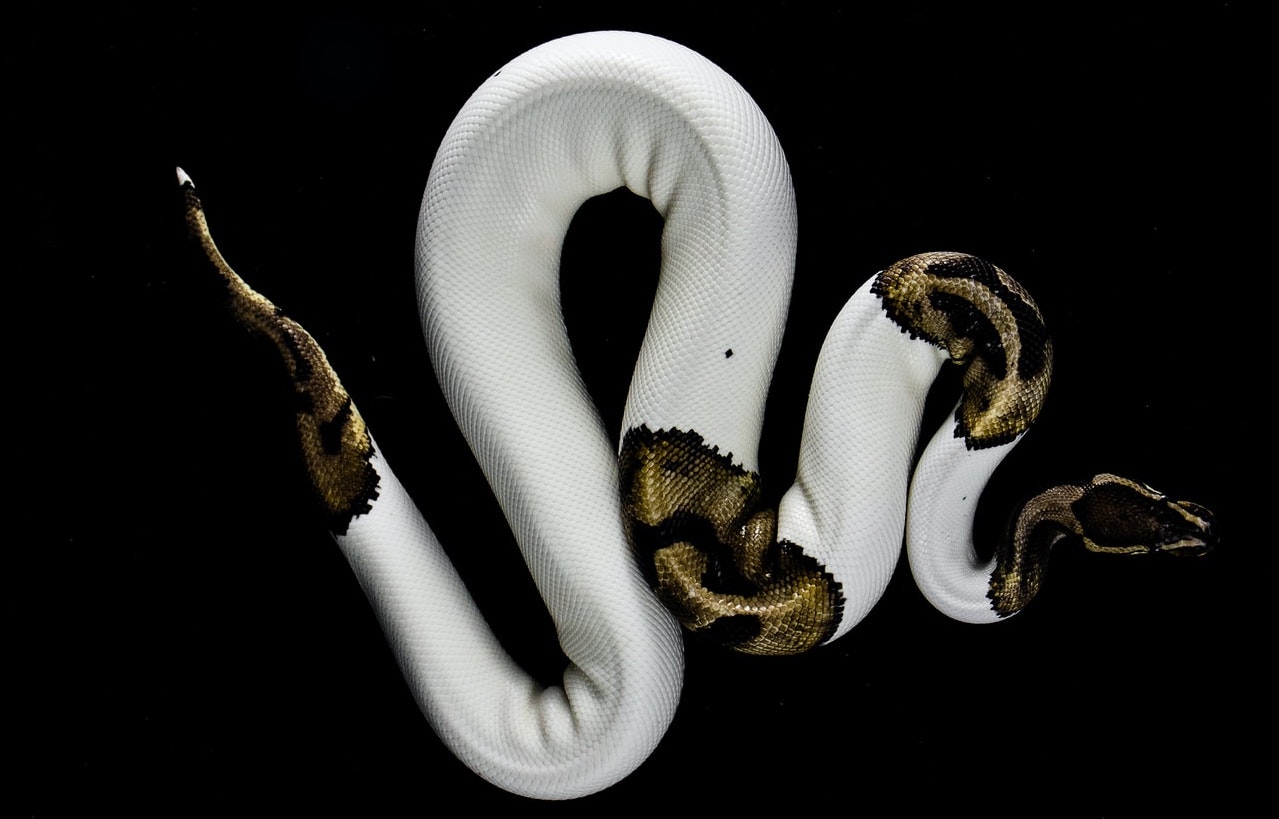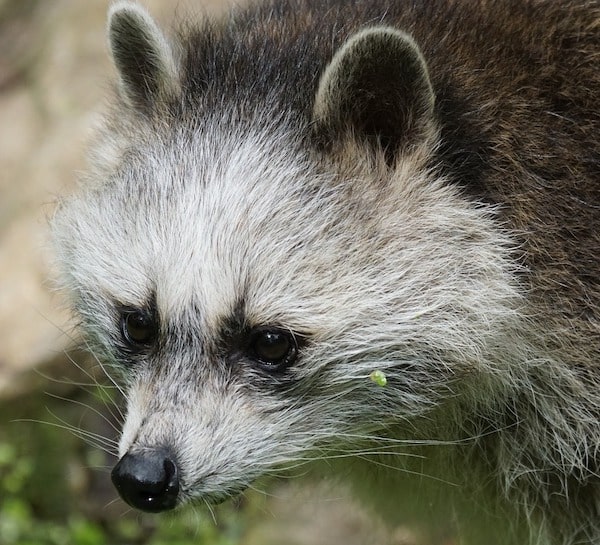The piebald ball python might be an ideal choice if you’ve considered adding a pet snake to your family. It’s relatively small and can be a rewarding addition to any home. But before you take the plunge, it pays to research these fascinating reptiles. This article will help educate potential owners on the secrets of how to care for a piebald ball python.
What is a piebald ball python?
A ball or royal python is a snake native to West and Central Africa. They’re called ball pythons because they curl up into a ball when they’re nervous. And they’re called royal pythons because the African rulers wore them like jewelry. Who needs precious metals anyway?
A piebald, or pied, python is a type of leucistic morph. Leucism is an albino with dark eyes instead of red. The colors, or lack thereof, are a recessive genetic anomaly that, like albinism, happens to two percent or less of all animals in the wild. However, morphed or abnormal (unique) color ball pythons are becoming more common as they’re bred in captivity.
What’s the difference between a piebald ball python and a normal one?
A piebald ball python has white splotches interspersed with color. You might even call it calico. Let’s check out the other main morphs.
Albinism is a total lack of melanin, leaving the ball python all white with red eyes. A leucistic ball python is all (or almost all) white with blue or dark-colored eyes. Then we skip over the average color to the melanistic morph, which is all black. Of course, normal or average is subjective. Hundreds of individual scale designs exist in the ball python world, each with a different value and cost.
How much does a piebald ball python cost?
A typical color ball python costs about $50 for a baby or juvenile – if they’re a common color. Piebald python babies and juveniles start at $300. The initial setup runs around $350, and the annual cost of owning one is about $150. Normal color adult ball pythons often cost between $150 – $500 but specially bred piebald pythons may empty your wallet of $800 or more. Newer, unseen colors can clear $7,000.
The most expensive ball python ever sold was an ivory ball python, and the breeder, Peter Kahl, sold the first one for $125,000. Now you can find one for as little as $150. Sort of like electronics. The more common an item is, the more affordable it becomes.
Why are piebald ball pythons so expensive?
The newer and more rare the color, the more you can charge. Piebald ball pythons aren’t as common as a standard color, so they’re worth twice as much or more. Even so, the newest reptile scale designs always top the cost of a piebald ball python.
Where can you find a piebald ball python?
You won’t find a piebald ball python at your local Petco or Petsmart. You can find a regular color, even an albino, at a chain store like that but go to a reptile shop for a specialty color. Plus, you’ll find a knowledgeable retailer to help you make an informed choice.
Are piebald ball pythons venomous?
Not only are ball pythons not venomous, but they’re also very docile. The chance of a piebald ball python biting you is relatively low.
What are a piebald ball python’s lifestyle, lifespan, and size?
This incredible creature can have an average lifespan of 20 to 30 years but can live up to 40 years in a few cases. They can grow up to six feet and weigh as much as nine pounds. The female is often 40% larger than the male.
They’re primarily crepuscular, meaning they’re most active around dusk and dawn but otherwise remain nocturnal. These quiet, docile creatures make wonderful pets for those preferring a reptile, and many owners keep their piebald ball pythons with them while working on the computer, watching TV, and even sleeping.
How do you care for a piebald ball python?
Your ball python may be low maintenance but still requires the basics for optimal health. Here are some tips to keep your pet at its best.
Enclosures
Your piebald ball python needs a large tank. Babies can live in a 20-gallon tank, but you need a 60-gallon tank for juveniles and adults. It’s best to purchase the large enclosure the first time. Make sure the tank is longer than it is tall.
Water
Ball pythons need clean, fresh water in a bowl big enough to soak in. Replace with fresh water daily. Or add a moving water feature for a drinking option and a large bowl to soak in.
Hiding places
Add in hides, or hiding places, for your ball python. Make sure you have at least three. Place one hide in the heated area, one in the cool area, and one in the humid area. Humidity can help your snake with shedding, a stressful and uncomfortable process. Hides should be large enough for your snake to fit its entire body. The humid hide should be placed somewhat warmer than the air temperature.
Substrate
In your pet’s enclosure, you’ll need to provide a substrate. The substrate is the bottom layer or substance. Ball pythons can use tropical soil mix, cypress mulch, orchid bark, newspaper or paper towels, coconut fiber, or aspen mulch.
- Although newspaper is inexpensive, it requires frequent replacement, and it could be more pleasing to the eye.
- Bark chips like orchid, fir, coconut, or beech are beautiful, suitable for humidity, and help with shedding. But your piebald ball python can ingest it with food and burrowing. Bark chips can create an impacted bowel in the snake’s digestive tract, so keep the substrate layer thin. An impacted bowel means that their feces are stuck in their intensines. It can be very painful for the snake and an expensive vet visit for your. Spot checks for quick cleaning work here.
- Cypress mulch is pretty and good for ball pythons because it’s absorbent and helps keep the right temperature and humidity level. It can get stuck in the snake’s nose or mouth. If you use this option, check your pet regularly for obstruction.
- Mix it with fir bark or cypress mulch when opting for sphagnum moss. Spray it sometimes to keep the moss moist.
- Aspen shavings clump easily when wet for prompt notice and simple cleaning. But your ball python may ingest the shavings or get them stuck in its mouth. If using this option, let your piebald ball python compress the substrate before feeding the snake. Watch for mold, and change aspen shavings monthly.
- Coconut fiber is another ingestion problem. However, it’s soft and clumps well, so it’s beneficial for humidity. Still, it can create a dusty mess and get stuck in the snake’s nose and mouth. Again, check your pet often for obstruction.
- A tropical soil mix is probably the best choice for humidity. You can create your own combination with 70% topsoil, 10% coco fiber, 10% peat moss, and 10% sand.
Your choice of ideal substrate depends on where you live and the location’s humidity levels. Humidity should stay between 55% to 80%. Glass terrariums should have a solid covering to maintain even moisture. Check your substrate for bugs or other pests. You can even bake or boil your underlayer for sanitation and safety.
Keep your piebald ball python’s substrate between two to seven inches. A smaller compacted base is enough, but deeper helps the humidity in larger environments. Besides spot cleaning, change the tank every month or so.
Lighting & Temperature
Keep your piebald ball pythons between 75-85 degrees Fahrenheit. Put your heater to one side to allow the snake to thermoregulate. This gives them the option to choose how warm or cold they want to be. Use ceramic emitters, day and night heat bulbs, undertank(UT) heaters, or heat tanks. Keep UT heaters outside the tank. Add a barrier between glass and heater to protect ball pythons from too much heat. Basking locations are at 85-90 degrees Fahrenheit. Avoid heated rocks or things that can burn the python.
What do I feed my piebald ball python?
Stick with frozen mice and rats when you feed your piebald ball python. Ball pythons like routine in their daily life, including their dietary needs. You want to use something affordable and available consistently. Babies start with smaller mice and move up as they grow. Switch to rats early for consistency and proper feeding when your ball python is large enough to eat one.
Because ball pythons can be fickle over food, sometimes you may need to tempt them with a live mouse or rat, if you can manage it. This may get your snake eating again, but try to stick with freshly thawed rats.
Never use a microwave to thaw the rodent. Pythons want their food as fresh and raw as possible. Warming it slowly to body temperature is preferable. Put the rodent in a sealed bag and under a heat lamp or in hot water to warm it.
Feed your pet once every two weeks. Adult piebald ball pythons will eat one to three rats per feeding, but no more. Babies will eat once a week.
Handling
After your piebald ball python has acclimated to its new environment, handle them weekly in ten-minute intervals at first. Give them a month to adjust and then build up to daily handling. Support your snake with both hands.
Diseases
Piebald ball pythons can carry Salmonella or deal with mites and ticks, mouth rot, or respiratory infections. Keep their enclosure clean and change it regularly to maintain health. Take them to a vet annually for their checkups.
What’s the difference between a male and a female?
Females are larger at (5ft) five feet and grow faster, reaching full size in 24-36 months. Males stay small, only growing to (3ft) three feet, and reach sexual maturity sooner at 12-18 months. Babies start at 10-14 inches.
Call an expert or watch a video for proper instruction to determine the sex of your piebald ball python. Probing may be informative, but it can be dangerous for your snake. So ensure you’re very careful and do it correctly without injuring your pet.
How do you breed a piebald ball python?
Size
Your breeding piebald ball pythons should be old enough and big enough. The female should be at least three years old, and it’s better if they weigh at least 60 ounces for optimal health. The male should weigh at least 24.7 ounces and be a minimum of a year in age. If a little pressure on the vent at the back of the snake (the cloaca) produces a white, cheesy substance (sperm plug), then you know the male is ready.
In Africa, clutches hatch in tortoise or rodent burrows during the breeding season, occurring from November to January. Then the eggs are laid in February. In captivity, breeding can occur year-round. You’ll need to prepare your snake’s temperature for three months before breeding.
Temperature
Keep the night temperature in the mid-70s and the warm spot in the cage at night in the mid to low 80s. During the day, the temperature should maintain the high 80s. It copies their natural habitat in Central Africa and tells their instincts it’s time to breed.
During this time, you’ll want to introduce your snakes to each other. Bring them together for a few days, then apart for a few more, and back and forth. Although they may attempt breeding, success will happen later – not right now.
After a few months of cooling them off, warm them up again. Your piebald ball python likes warmer temperatures.
Excitement
If your male needs some extra stimulation, introduce him to several males. Twenty minutes around the guys have them ready to get happy with a girl. Then, put him back with the girl and leave them alone.
Copulation
When mating, piebald ball pythons lock together in copulation for up to two days. If breeding a male more than once, he’ll need a week at least before he can do it again. Keep bringing them together for mating until you see the outline of eggs inside her.
The female can take even longer to use all that sperm. It can stay viable for two whole years in her body.
Nesting
Get her a big box with damp moss. She lays her eggs clutch, or nest of eggs, laying 3-14 eggs at a time. Then she incubates them for two months by wrapping herself around them to maintain 86-88 Fahrenheit. She won’t eat at all during this time. However, you can remove the eggs and incubate them at a constant 90 degrees Fahrenheit. Leave your incubation container alone, checking weekly only.
If incubating, you may need to wash the egg smell from your female to convince her to eat.
Hatching
After 55-60 days, the young start to emerge. Babies can take up to 24 hours to break out of their shells. Then they’re on their own and living off the energy from the egg for up to ten days. After that, they’re ready to transition to mice and rats.
The tail end
You and your piebald ball python can enjoy a fulfilling familial bond for decades. Whether you choose to breed your pet or not, the relationship you create can be worth the initial and annual cost of maintaining your ball python. In addition, understanding their personality can enrich your life with their calming presence.
Your piebald ball python is special and unique, worthy of a long and caring relationship for many years to come.
Do you know how you catch a unique ball python? You-nique up on it!

This is a piebald ball python. that means that it is partially albino in coloring and the other part normal coloration.



Thanks for your post. One other thing is when you are promoting your property by yourself, one of the issues you need to be alert to upfront is when to deal with household inspection reports. As a FSBO supplier, the key about successfully moving your property along with saving money upon real estate agent revenue is knowledge. The more you understand, the better your sales effort will likely be. One area that this is particularly significant is inspection reports.